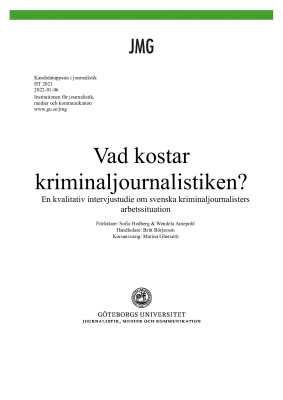Vad kostar kriminaljournalistiken?
En kvalitativ intervjustudie om svenska kriminaljournalisters arbetssituation
The aim of this study is to look into the work conditions of eight Swedish crime journalists
and investigate how they experience their work environment, the support from employees, their safety and how they are coping with threats, hatred and strains. We will look into if and
how their work covering crime affects their personal lives and if threats and hatred risks to lead to self-censorship. To fulfil this aim, three main questions were constructed:
1. How do Swedish crime journalists experience their work? Are they exposed to hatred
and/or threats?
2. How does the crime journalist’s personal lives get affected by their work?
3. How do Swedish crime journalists cope with hatred, threats and strains?
a) How do they experience the support from their employees?
b) Does hatred and threats risk to lead to self-censorship?
We have used a qualitative interview method to help us answer our questions.
With Monica Löfgren Nilssons quantitative research: Hatred and threats against Swedish journalists as a starting point, we hope to look deeper into specific journalists’ work environments and what kind of hatred, threats and strains they experience.
The theoretical framework of the study includes the Coping theory, Job-Control-Demand-Support model and the Role theory. The theories helped us to analyze
and discuss our results which lead us to a numerous of conclusions. First of all, working with crime journalism is a very stressful and consuming job which requires a strong belief in the journalistic professional standards. All the interviewees share the perception that working with crime journalism is “a way of life”. They find it challenging to keep a distans to work when they enter their private life.
The majority of our interviewees have experienced some kind of hate and/or threats connected to their work. Their coping methods vary but some of the most common ones were to accept their situation and talk to colleagues or partners. Some of the interviewees are in need of safety precautions due to threats, for example protected personal information or
camera surveillance. Measures like this have an impact on their families as well. We found that most of the interviewees are pleased with the support that they receive from their employers, but that some find that there is room for improvement.
We found that self-censorship occurred in two cases, but that it does not seem to be a
common pattern among the crime journalists we spoke to.

